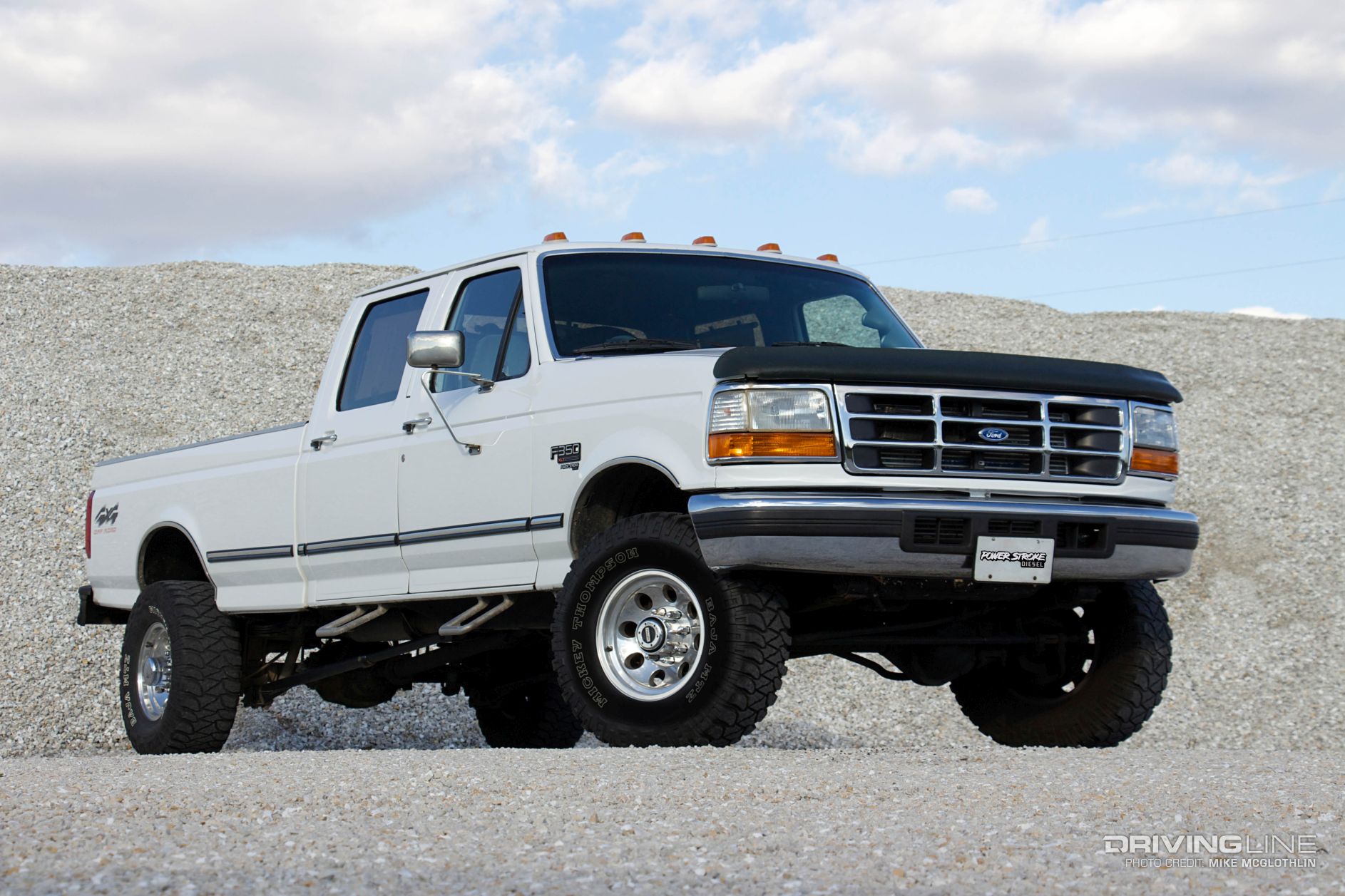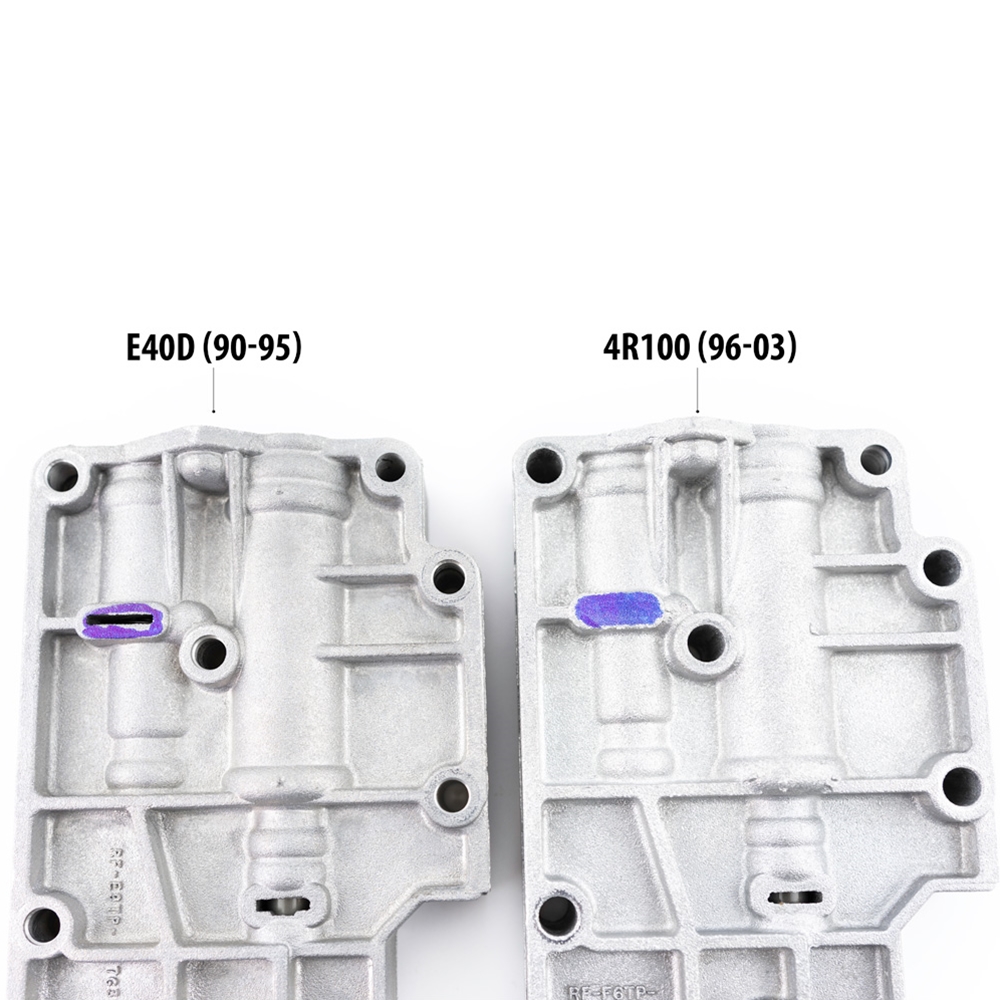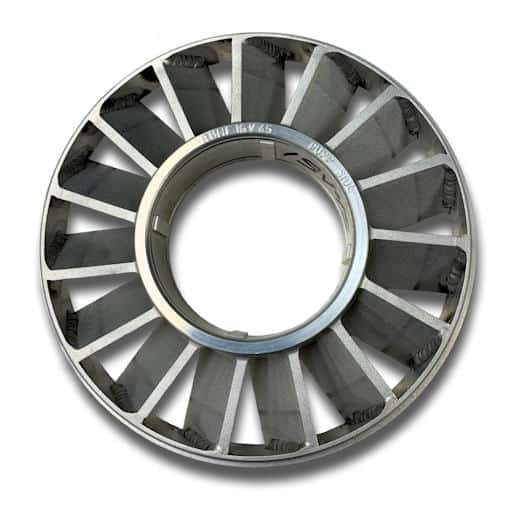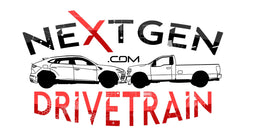Table of Contents:
- Introduction to the Ford 4R100 Transmission
- Ford 4R100 Product Resources
- Popular Transmission Information Resources
- Do I have an E40D or a 4R100?
-What are the key differences between the two?
- Problem #1 - The Torque Converter
- Problem #2 - The Valve Body
- Problem #3 - The Overdrive Clutch Pack
- Problem #4 - The High Pressure Oil Pump
- Problem #5 - The Factory Oil Pan
- Problem #6 - The Input Shaft
- Problem #7 - The Overdrive Planetary Assembly
- Problem #8 - The Solenoid Block
- Problem #9 - The Intermediate Sprag Assembly
- Conclusion to the Ford 4R100 Transmission

Introduction to the Ford 4R100 Transmission:
The Ford 4R100 transmissions are well known, historic transmissions that are still on the road today in many Super Duties from the turn of the century. But, did you know that many of their internal design culture originates from the C6 dinosaur transmission? It's no secret that the 4R100 transmissions of the world are imperfect. The main thing helping them survive throughout time is the fact that they're generally mated to lower power vehicles such as the 7.3L Power Stroke. This saves many of their failure points from view.
However, these common transmissions frequently suffer when exposed to added power, larger tires, heavier duty applications or even higher mileage. Even if nothing "breaks", these transmissions are challenged to survive past 150,000 miles before quickly degrading. This is common as OEM's only truly care about reliability inside the warranty period of the vehicle. After the 100,000 mile mark, they are no longer financially incentivized to ensure the reliability of the components of the vehicle. In this article, we will be analyzing all of the critical information, popular failure points and fixes of these historic transmissions.
Ford 4R100 Product Resources:
- 4R100 Transmissions
- 4R100 Torque Converters
- 4R100 Rebuild Kits
- 4R100 Valve Bodies
- 4R100 Parts
Popular Transmission Information Resources:
- Top 5 Benefits of an Upgraded or Built Transmission
- Calculating Torque Multiplication Factor, Why is it So Important?
- Top 5 Ways to Extend the Life of a Factory Transmission
Do I have an E40D or a 4R100?
Going into the 1989 model year, Ford needed a lockup capable 4 speed transmission with overdrive to continue being market competitive. At this time, GM and Chrysler were both introducing 4 speed electronic automatics with overdrive functions. Chronologically, the E40D transmission came first. This transmission was used from model year 1989 through model year 1998.
As power levels and consumer demands grew, Ford knew they had to revisit the E40D transmission and implement some updates to make it more equipped for the new Super Duty trucks being released. In 1998, the 4R100 was released. The transmission was used early in the fleet-intensive Econoline series vehicles from 1997 as a "beta" for the product. The 4R100 transmissions production was discontinued for 2003, as the 5R110 transmission was released, ending an era of 4 speed heavy duty transmissions under the Ford brand.
As a general rule of thumb, if your vehicle is 1989 through 1998, you have an E40D transmission. If your vehicle is 1999 through 2003, you have a 4R100 transmission. There are a few exceptions to this, so if you need E40D or 4R100 transmission parts or replacements, it is best to call us to confirm what transmission your vehicle has. This will ensure fitment and reliability.
What are the key differences between the two?
Although extremely similar, the E40D transmission is not quite the same as it's newer frat, the 4R100 transmission. Firstly, the 4R100 came with the implementation of a PWM (Pulse-Width Modulated) torque converter clutch solenoid to control lockup electronically. This was designed to resolve converter drag and burnt converter clutches in high stress applications.
In addition to this, there was the implementation of an output speed sensor. This helps the transmission identify when it's slipping more accurately. The 4R100 transmission rationalizes input shaft to output shaft speed to identify slippage, similar to how a motorcycle ABS or traction control system rationalizes front wheel speed to rear wheel speed to identify slippage.
A final major difference is the oil pump. The 4R100 transmission oil pump was designed to produce line pressure faster and more efficiently than the original E40D transmission could. This was supposed to support an increase in torque capacity at the clutch packs, but only had so much impact. Now, with this fundamental understanding, we will analyze the prolific problems and solutions of the 4R100 transmissions.
Problem #1 - The Torque Converter
As with most transmissions that have a torque converter, the torque converter was designed to be cheap rather than strong. OEM's are incredibly cheap about manufacturing transmissions, especially in-house. The goal is always to maximize profits, putting the reliability of your transmission last. The Ford 4R100 torque converters share common failure points.
To begin, one popular failure point in these converters is the lockup clutches themselves. This is the clutch pack at the front of the converter that activates in upper gears to improve power and fuel economy. From the factory, they are extremely thin disks that have little to offer in terms of power capacity and longevity. Many heavy duty applications, tuned trucks and simply higher mileage trucks have lockup mechanisms that apply extremely slowly, or perhaps not at all. Upgraded converter clutches are a standard in all torque converters that we manufacture for the Ford 4R100 transmissions.
Additionally, the stator is designed so as to minimize idling emissions first, and support power and driving feel second. This is because the stator is the component used to control stall speed, the maximum allowable difference in speed between the motor and the input shaft. As with many transmissions from it's era, these torque converters were designed to allow for liberal slippage in lower gears, minimizing engine load and in turn fuel consumption at idle.
The downside is that this causes the truck to be much much less responsive, robbing you of power in exchange for intense heat in lower gears. Because of this, all Next Gen Drivetrain Ford 4R100 torque converters feature a precision machined stator designed to optimize for efficiency and reliability, often increasing bottom end power as well.
Problem #2 - The Valve Body
When the 4R100 transmission was released, one of it's major differences from it's predecessor, the C6, was the valve body. Ford had to totally redesign the valve body to allow for the usage of a 4th gear overdrive as well as a lockup mechanism. Unfortunately, they made an intensely cheap valve body assembly, prone to many crossleaks and flexion points.
In fact, the valve body is part of the reason these transmissions tend to shift so slowly and unpredictably at higher mileages. Upgrading the valve body produces immense improvements in drivability and reliability, making it an important area of analysis.
Firstly, the valve body leaks regularly at areas such as the pressure regulator boost valve, line regulator valve and 1-2 shift valve. These valves are made of cheap materials that are prone to bore wear at remarkably low mileages. This causes the transmission to be less responsive, operate at higher temperatures, and shift in an unfavorable fashion.
Additionally, the valve body is made of a soft aluminum that is prone to flexion. As it flexes, much like a head gasket, it begins to cross-pollenate different oil circuits with one another, leading to collateral issues. Although some companies are milling these valve bodies flat to support healthy seal, we have gone so far as to invent a multiple times thicker crushing style steel separator plate, creating a truly air-tight seal at the transmission.
Problem #3 - The Overdrive Clutch Pack
As with almost all overdrive transmissions, it is a challenge to keep the overdrive clutches together under heavy load. This is because overdriven gears naturally have the highest torque multiplication factor of any of the gears transmissions use; especially with the lockup clutches engaged. As a result, burnt overdrive clutches are exceedingly common on 4R100 transmissions.
The problem is caused by a combination of two things. One is inadequate clutch volume at the clutch pack, there is simply not enough friction material in that part of the transmission to support intense loads as many of these consumers demand. The second problem is a loss of line pressure over time due to the large quantity of crossleaks found in the oil pump as well as the valve body.
To negate this issue to our clients, we use a variety of different overdrive setups, offering upgraded clutch materials with higher braking torque and occasionally additional clutches in this portion of the transmission. This fortifies the transmission's ability to hold more torque and load under a much more expansive range of applications. As for the oil pump and valve body assembly, both are heavily modified to ensure closure of all prolific crossleaks, ensuring the longevity of the welcoming and high quality shift behavior of our upgraded transmissions.
Problem #4 - The High Pressure Oil Pump
Although the high pressure oil pump or the E40D and 4R100 transmissions are different, their issues are quite congruent. They are often reliable on day one, but quickly lose their ability to produce pressure quickly, predictably and effectively. This in turn takes from the clutch packs ability to stay together when engaged, decreasing the power capacity of the transmission.
The first concern is the pump gears themselves. As the pump gears rotate literally millions of times throughout their life, microcontaminants in the oil as well as side load will cause wear to the outer area where the pump gears ride. By doing so, it allows oil to revert out of the pump, taking directly from the clutch packs. This can be seen as a pressure drop-off on the top end of the line pressure range.
Additionally, the PWM (Pulse-Width Modulated) lockup valve inside the pump causes extremely slow clutch engagement, burning the converter clutches throughout time. We offer a standard modification in all 4R100 transmissions that converts this design to a simple on/off logic oil circuit, yielding faster, crisper and safer lockup clutch engagement. This valve system is also sleeved to prevent longevity concerns.
Problem #5 - The Factory Oil Pan
Although not a huge detracting factor, it should be noted that the OEM oil pan is low in volume, dismally weak in strength and contributes to sustained higher operating temperatures; an obvious negative. Aftermarket Cast Aluminum Extra Deep Oil Pans allow for added oil volume, decreasing the AOT (Average Operating Temperature) of the transmission.
Also, their rigidity supports the strength of the case by functioning as a girdle of sorts. Keep in mind, these pans cannot flex as much as an OEM pan, helping to support the case in rigorous applications where case failure can occur. This is why installing a cast aluminum deep pan can be one of the best forms of insurance against a broken case.
Problem #6 - The Input Shaft
The E40D and 4R100 input shafts are the same, and hence have the same failure points and benefits. The factory input shaft is solid, with no oil circuit traveling through the middle. This makes it generally stronger than many other shafts that are hollow internally. However, it's certainly not invincible.
Some more intense applications will suffer from input shaft failure. This can be caused by aggressive torque converter lockup, heavy loads, added power, larger tires and more. For applications as such, many prefer to use a billet input shaft, made of strengthened steel.
There are 3 different types of billet input shaft available for the 4R100 transmissions. The first, is 300M, a material that is about 35% stronger than the OEM shaft. Secondarily, is Maraging Steel, at roughly 60% stronger. Lastly, is AERMET, a very rare steel alloy providing nearly double the strength of the OEM transmission's input shaft. Although not everyone needs a billet input shaft, it is certainly an affordable form of insurance from expensive and demobilizing failure.
Problem #7 - The Overdrive Planetary Assembly
Tangential to the overdrive clutches failing, is the overdrive assembly itself. This planetary assembly synchronizes in speed with the input shaft and causes the output shaft to travel even faster than the input shaft. This puts a tremendous amount of stress on this specific planetary assembly. 
Although it is unlikely to fail in bone-stock applications, those seeking to use their vehicles for added power or heavy duty applications will be likely to experience failure to this specific component. Fortunately, it is a standard in our middle and upper level 4R100 transmissions to use a billet steel overdrive planetary assembly.
In doing so, we enable the transmission to withstand a massive amount of load reliably. Further, we can use more overdrive clutches safely without the concern of applying too much stress to this failure prone component. If you desire to be rough with your transmission, a billet overdrive planetary assembly is a very cogent upgrade.
Problem #8 - The Solenoid Block
As with most electronic transmissions, solenoids are an inevitable issue as time goes on. The solenoids of the 4R100 transmission are confined to an assembly known as the "solenoid block", containing all of the critical electronics responsible for controlling shift behavior. This solenoid block, unfortunately, does not have a very good track record from the OEM.
As time went on, Ford progressed to redesign and update the solenoid block multiple times, giving it successor part numbers. The most current iteration of the solenoid block is quite reliable, the issue is that few people have the most current solenoid block in their transmissions. Many of the older solenoid blocks were prone to copper windings burning out internally, as well as weather-proofing concerns.
All solenoid blocks sold at Next Gen Drivetrain are only the most current iteration, preventing our clients from facing these specific concerns. It is standard in all new 4R100 transmissions that we offer to use a new OEM updated solenoid block.
Problem #9 - The Intermediate Sprag Assembly
Sprag assemblies are one-way clutch systems used in many transmissions to prevent things from rotating the opposite direction of what it was designed to. Like many 4 speeds, there is an intermediate sprag assembly used to do just this in the 4R100 transmission. Unfortunately, it's a very cheap piece of plastic that tends to blow apart in towing applications as well as tuned applications.
An easy solution is a simple drop-in upgraded sprag that features additional "elements" to more equally distribute load across the device, making it much harder to break. This is a little known modification that many transmission remanufacturing companies do not use in their 4R100 transmission. It's a standard practice in all transmissions and rebuild kits that we offer for these units to include a heavily upgraded 45 element sprag.
Conclusion to the Ford 4R100 Transmission:
As one could see, the 4R100 transmissions are not perfect. It's quite common that they will experience issues with hydraulics, hard parts and electronics, rendering them immobile. Next Gen has spent an enormous amount of time understanding, developing and delivering the most reliable versions of these transmissions achievable. If you still have questions about your 4R100 transmission, feel free to call in and speak to one of our experts!







Comments (5)
I have a 2002 7.3 with the r4100. It shifts fine when initially driving when cold but 10 minutes or so when warmed up it will not shift from 2nd to 3rd. There are no other issues with it.
Hi I have a 4R100 in a 99 F250 4×4. I had a situation that it kind of sounds like it’s shifting in and out, in and out between 3-OD when towing.
I just had it rebuilt by a reputable trans guy for the tune of $5K ;included re & re) and it still does the same thing! He says it’s not the trans ? Any ideas? It’s really making me upset.
If you want I can be reached at 250-216-3371.
I have one of the first 99 f350 that was released in 98. I purchased it in April of 98. I want to confirm if it has a 4R100 or an E40D.
Kyle Taylor: I worked on a F-Super Duty with the e4od and 7.3 that had that happen. It turned out to be a short in the portion of the tow package trailer harness under the hood. The BOO switch on those is tied into the torque converter lockup to my understanding: So if the brake wiring is shorted to ground or power weird things can happen. I think the torque converter was locking up at a stop due to power backfeed — causing a stall. Check the brake wiring — especially at the connection points — near the pedal, the connectors for tow package under the hood / at the brake controller, and at the rear near the trailer plug.
Hello I have 2002 f250 7.3 I have problems with my 4r100 such as it will stall when put it in reverse or when braking for a stop light. It shifts hard.
I also have added power.
I had my trans rebuilt once they put a triple disc in it as far as I know what can I do to get my truck to stop stalling.
Thanks